FTMS College Research Proposal: Impact of AI on Human Capital
VerifiedAdded on 2022/11/28
|18
|4474
|169
Project
AI Summary
This research proposal examines the impact of artificial intelligence (AI) on human capital, focusing on the context of Malaysia. The study aims to explore the conceptual understanding of AI and human capital, address the impact of AI on various HR functions such as recruitment, training, and employee development, and recommend AI strategies to improve human capital management. The proposal includes a literature review covering definitions of AI and human capital, the impact of AI on areas like bias reduction, personalization, and training, and strategies for improvement. The methodology section outlines an interpretivism research philosophy, a survey-based research design, and data analysis plans. The research is significant for academics, practitioners, and companies seeking to understand and leverage AI to enhance their human capital. The study addresses a research gap related to the limited depth of data on the impact of AI on human capital and provides a conceptual framework illustrating the relationship between AI as the independent variable and human capital as the dependent variable.
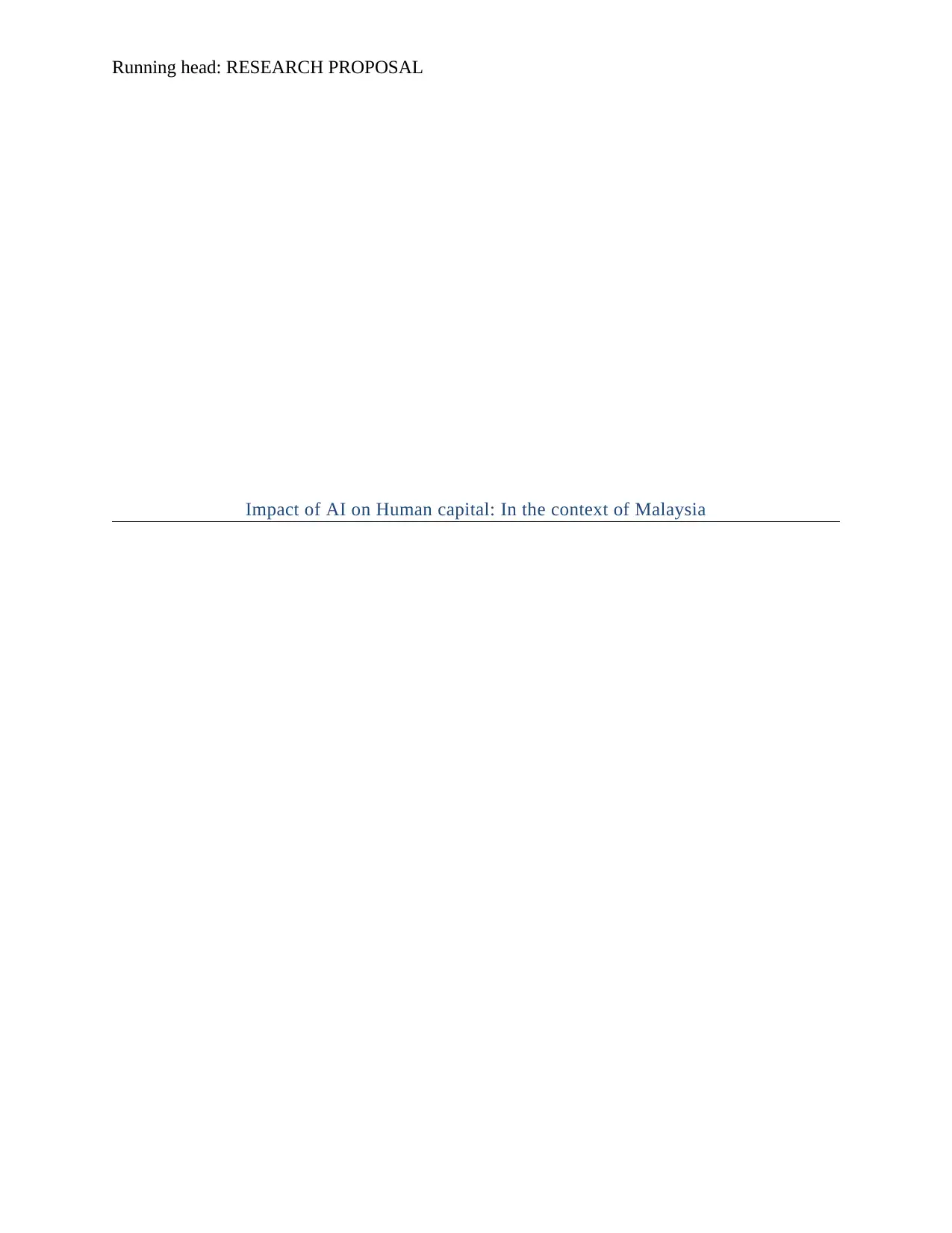
Running head: RESEARCH PROPOSAL
Impact of AI on Human capital: In the context of Malaysia
Impact of AI on Human capital: In the context of Malaysia
Paraphrase This Document
Need a fresh take? Get an instant paraphrase of this document with our AI Paraphraser
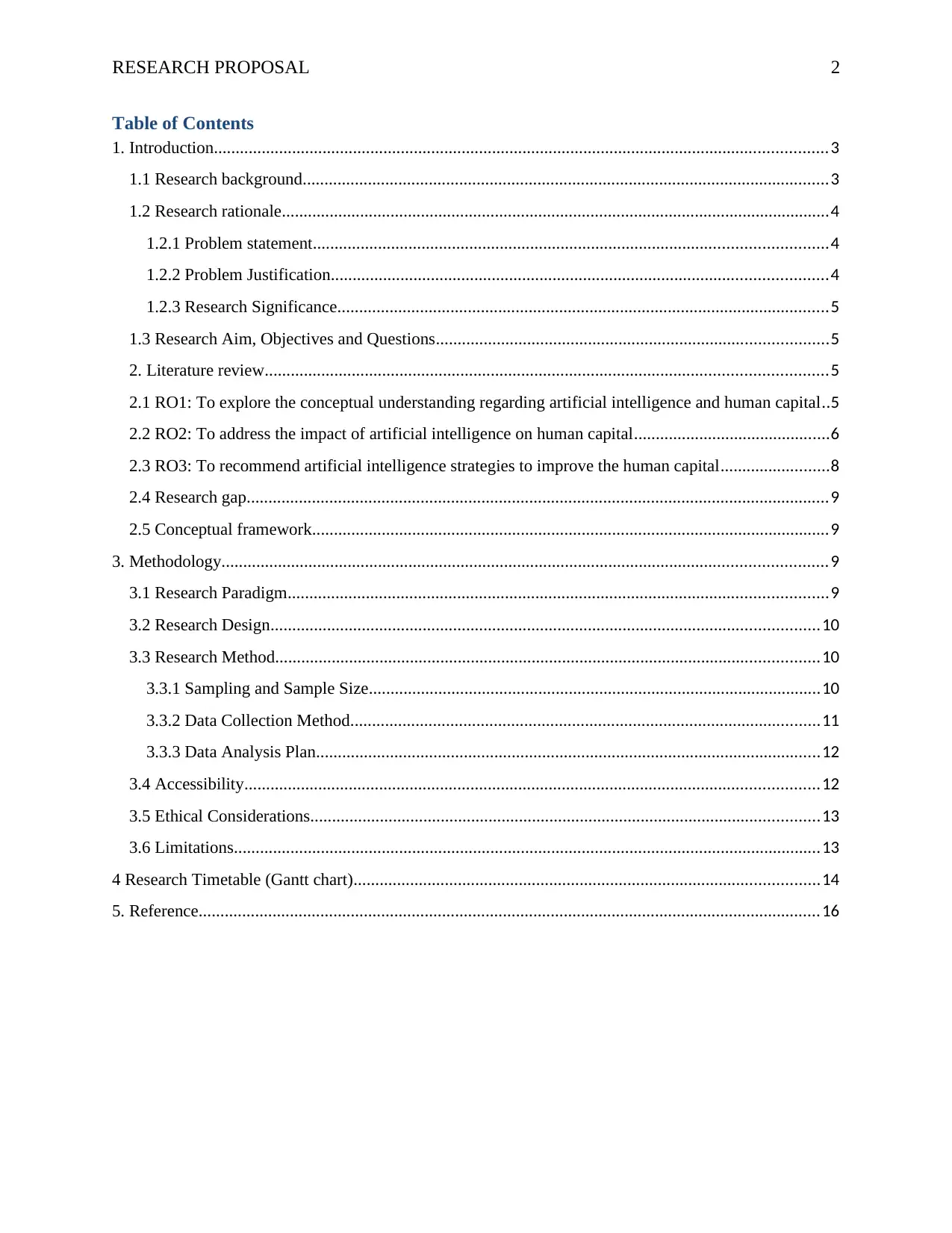
RESEARCH PROPOSAL 2
Table of Contents
1. Introduction.............................................................................................................................................3
1.1 Research background.........................................................................................................................3
1.2 Research rationale..............................................................................................................................4
1.2.1 Problem statement......................................................................................................................4
1.2.2 Problem Justification..................................................................................................................4
1.2.3 Research Significance.................................................................................................................5
1.3 Research Aim, Objectives and Questions..........................................................................................5
2. Literature review.................................................................................................................................5
2.1 RO1: To explore the conceptual understanding regarding artificial intelligence and human capital..5
2.2 RO2: To address the impact of artificial intelligence on human capital.............................................6
2.3 RO3: To recommend artificial intelligence strategies to improve the human capital.........................8
2.4 Research gap......................................................................................................................................9
2.5 Conceptual framework.......................................................................................................................9
3. Methodology...........................................................................................................................................9
3.1 Research Paradigm............................................................................................................................9
3.2 Research Design..............................................................................................................................10
3.3 Research Method.............................................................................................................................10
3.3.1 Sampling and Sample Size........................................................................................................10
3.3.2 Data Collection Method............................................................................................................11
3.3.3 Data Analysis Plan....................................................................................................................12
3.4 Accessibility....................................................................................................................................12
3.5 Ethical Considerations.....................................................................................................................13
3.6 Limitations.......................................................................................................................................13
4 Research Timetable (Gantt chart)...........................................................................................................14
5. Reference...............................................................................................................................................16
Table of Contents
1. Introduction.............................................................................................................................................3
1.1 Research background.........................................................................................................................3
1.2 Research rationale..............................................................................................................................4
1.2.1 Problem statement......................................................................................................................4
1.2.2 Problem Justification..................................................................................................................4
1.2.3 Research Significance.................................................................................................................5
1.3 Research Aim, Objectives and Questions..........................................................................................5
2. Literature review.................................................................................................................................5
2.1 RO1: To explore the conceptual understanding regarding artificial intelligence and human capital..5
2.2 RO2: To address the impact of artificial intelligence on human capital.............................................6
2.3 RO3: To recommend artificial intelligence strategies to improve the human capital.........................8
2.4 Research gap......................................................................................................................................9
2.5 Conceptual framework.......................................................................................................................9
3. Methodology...........................................................................................................................................9
3.1 Research Paradigm............................................................................................................................9
3.2 Research Design..............................................................................................................................10
3.3 Research Method.............................................................................................................................10
3.3.1 Sampling and Sample Size........................................................................................................10
3.3.2 Data Collection Method............................................................................................................11
3.3.3 Data Analysis Plan....................................................................................................................12
3.4 Accessibility....................................................................................................................................12
3.5 Ethical Considerations.....................................................................................................................13
3.6 Limitations.......................................................................................................................................13
4 Research Timetable (Gantt chart)...........................................................................................................14
5. Reference...............................................................................................................................................16
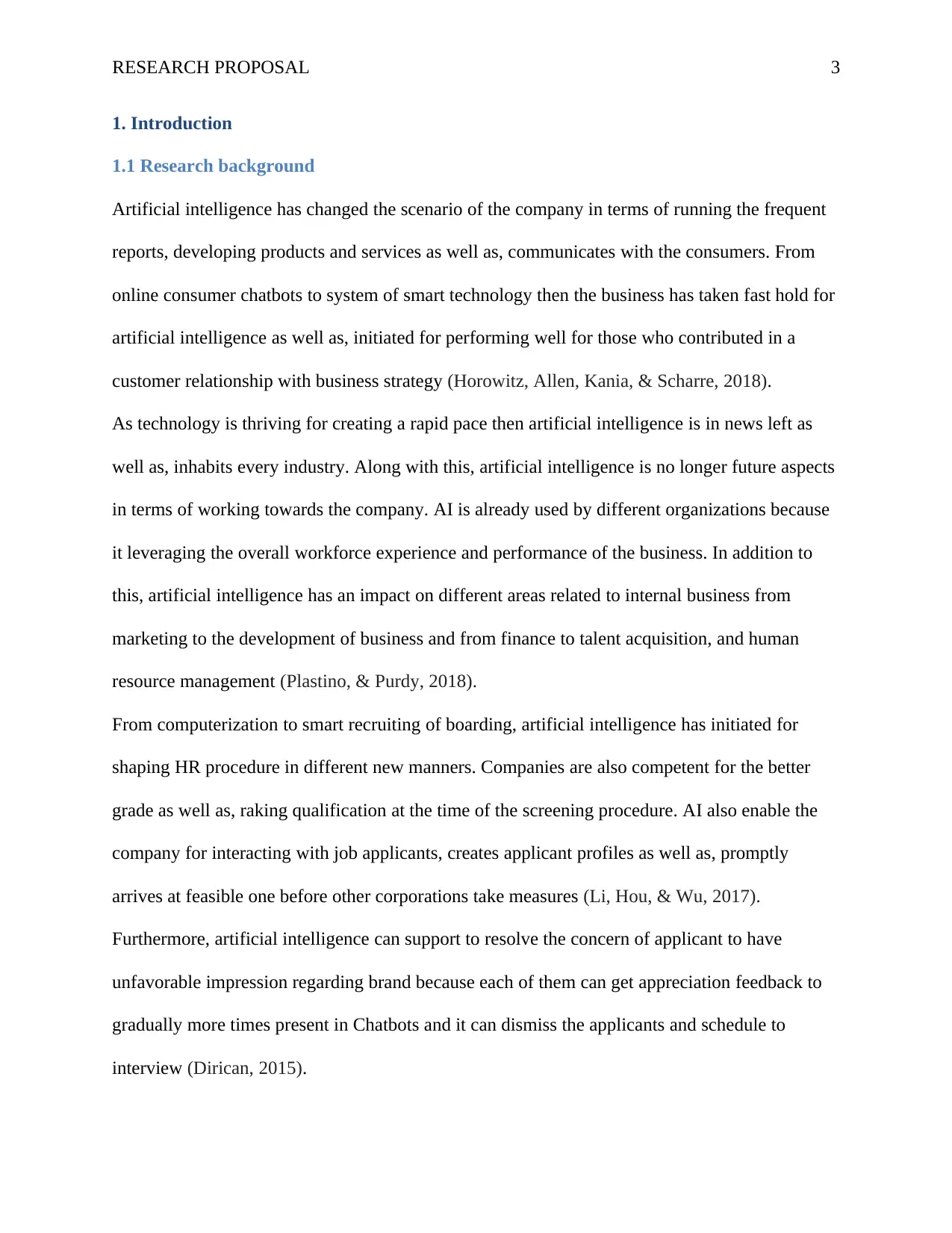
RESEARCH PROPOSAL 3
1. Introduction
1.1 Research background
Artificial intelligence has changed the scenario of the company in terms of running the frequent
reports, developing products and services as well as, communicates with the consumers. From
online consumer chatbots to system of smart technology then the business has taken fast hold for
artificial intelligence as well as, initiated for performing well for those who contributed in a
customer relationship with business strategy (Horowitz, Allen, Kania, & Scharre, 2018).
As technology is thriving for creating a rapid pace then artificial intelligence is in news left as
well as, inhabits every industry. Along with this, artificial intelligence is no longer future aspects
in terms of working towards the company. AI is already used by different organizations because
it leveraging the overall workforce experience and performance of the business. In addition to
this, artificial intelligence has an impact on different areas related to internal business from
marketing to the development of business and from finance to talent acquisition, and human
resource management (Plastino, & Purdy, 2018).
From computerization to smart recruiting of boarding, artificial intelligence has initiated for
shaping HR procedure in different new manners. Companies are also competent for the better
grade as well as, raking qualification at the time of the screening procedure. AI also enable the
company for interacting with job applicants, creates applicant profiles as well as, promptly
arrives at feasible one before other corporations take measures (Li, Hou, & Wu, 2017).
Furthermore, artificial intelligence can support to resolve the concern of applicant to have
unfavorable impression regarding brand because each of them can get appreciation feedback to
gradually more times present in Chatbots and it can dismiss the applicants and schedule to
interview (Dirican, 2015).
1. Introduction
1.1 Research background
Artificial intelligence has changed the scenario of the company in terms of running the frequent
reports, developing products and services as well as, communicates with the consumers. From
online consumer chatbots to system of smart technology then the business has taken fast hold for
artificial intelligence as well as, initiated for performing well for those who contributed in a
customer relationship with business strategy (Horowitz, Allen, Kania, & Scharre, 2018).
As technology is thriving for creating a rapid pace then artificial intelligence is in news left as
well as, inhabits every industry. Along with this, artificial intelligence is no longer future aspects
in terms of working towards the company. AI is already used by different organizations because
it leveraging the overall workforce experience and performance of the business. In addition to
this, artificial intelligence has an impact on different areas related to internal business from
marketing to the development of business and from finance to talent acquisition, and human
resource management (Plastino, & Purdy, 2018).
From computerization to smart recruiting of boarding, artificial intelligence has initiated for
shaping HR procedure in different new manners. Companies are also competent for the better
grade as well as, raking qualification at the time of the screening procedure. AI also enable the
company for interacting with job applicants, creates applicant profiles as well as, promptly
arrives at feasible one before other corporations take measures (Li, Hou, & Wu, 2017).
Furthermore, artificial intelligence can support to resolve the concern of applicant to have
unfavorable impression regarding brand because each of them can get appreciation feedback to
gradually more times present in Chatbots and it can dismiss the applicants and schedule to
interview (Dirican, 2015).
⊘ This is a preview!⊘
Do you want full access?
Subscribe today to unlock all pages.

Trusted by 1+ million students worldwide
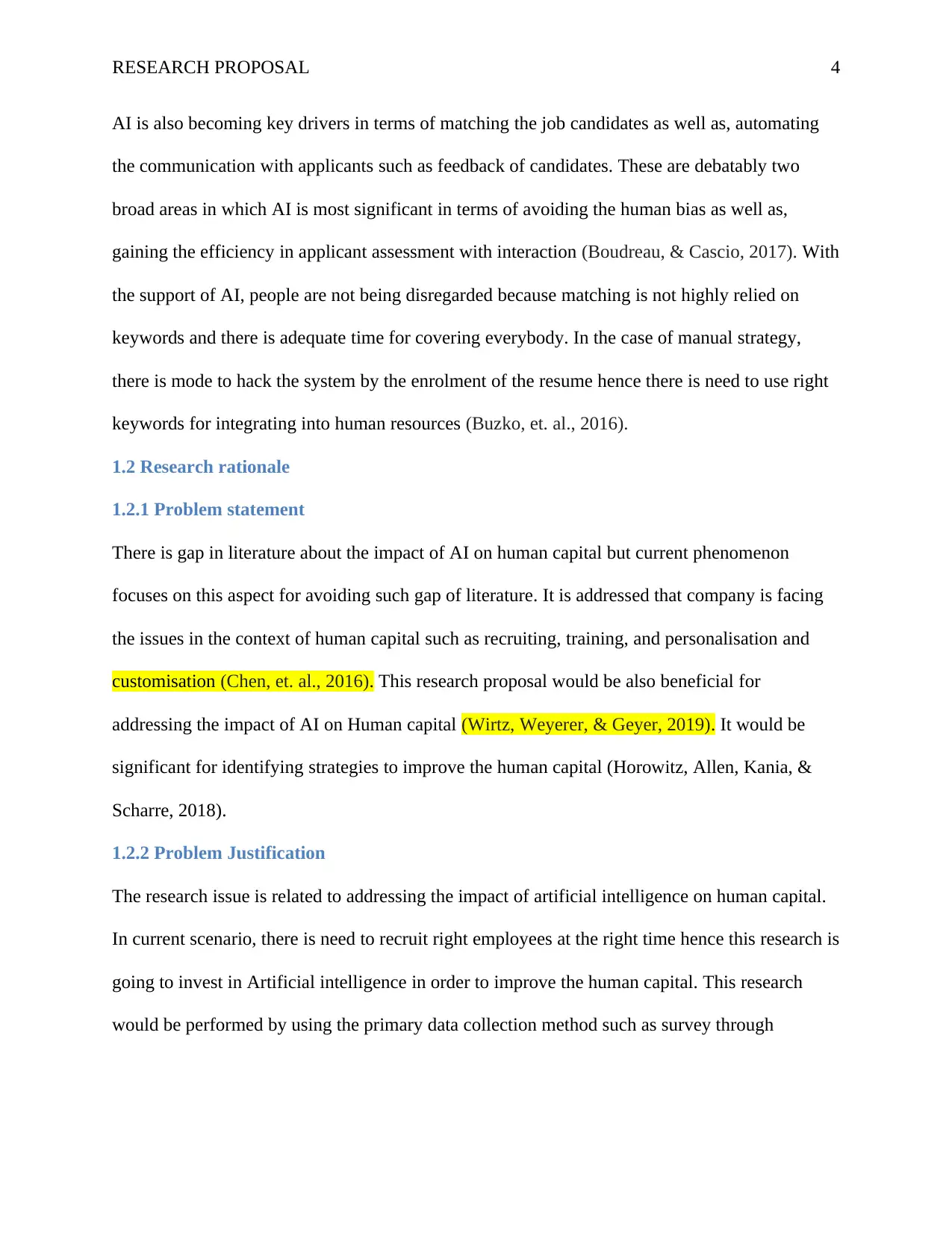
RESEARCH PROPOSAL 4
AI is also becoming key drivers in terms of matching the job candidates as well as, automating
the communication with applicants such as feedback of candidates. These are debatably two
broad areas in which AI is most significant in terms of avoiding the human bias as well as,
gaining the efficiency in applicant assessment with interaction (Boudreau, & Cascio, 2017). With
the support of AI, people are not being disregarded because matching is not highly relied on
keywords and there is adequate time for covering everybody. In the case of manual strategy,
there is mode to hack the system by the enrolment of the resume hence there is need to use right
keywords for integrating into human resources (Buzko, et. al., 2016).
1.2 Research rationale
1.2.1 Problem statement
There is gap in literature about the impact of AI on human capital but current phenomenon
focuses on this aspect for avoiding such gap of literature. It is addressed that company is facing
the issues in the context of human capital such as recruiting, training, and personalisation and
customisation (Chen, et. al., 2016). This research proposal would be also beneficial for
addressing the impact of AI on Human capital (Wirtz, Weyerer, & Geyer, 2019). It would be
significant for identifying strategies to improve the human capital (Horowitz, Allen, Kania, &
Scharre, 2018).
1.2.2 Problem Justification
The research issue is related to addressing the impact of artificial intelligence on human capital.
In current scenario, there is need to recruit right employees at the right time hence this research is
going to invest in Artificial intelligence in order to improve the human capital. This research
would be performed by using the primary data collection method such as survey through
AI is also becoming key drivers in terms of matching the job candidates as well as, automating
the communication with applicants such as feedback of candidates. These are debatably two
broad areas in which AI is most significant in terms of avoiding the human bias as well as,
gaining the efficiency in applicant assessment with interaction (Boudreau, & Cascio, 2017). With
the support of AI, people are not being disregarded because matching is not highly relied on
keywords and there is adequate time for covering everybody. In the case of manual strategy,
there is mode to hack the system by the enrolment of the resume hence there is need to use right
keywords for integrating into human resources (Buzko, et. al., 2016).
1.2 Research rationale
1.2.1 Problem statement
There is gap in literature about the impact of AI on human capital but current phenomenon
focuses on this aspect for avoiding such gap of literature. It is addressed that company is facing
the issues in the context of human capital such as recruiting, training, and personalisation and
customisation (Chen, et. al., 2016). This research proposal would be also beneficial for
addressing the impact of AI on Human capital (Wirtz, Weyerer, & Geyer, 2019). It would be
significant for identifying strategies to improve the human capital (Horowitz, Allen, Kania, &
Scharre, 2018).
1.2.2 Problem Justification
The research issue is related to addressing the impact of artificial intelligence on human capital.
In current scenario, there is need to recruit right employees at the right time hence this research is
going to invest in Artificial intelligence in order to improve the human capital. This research
would be performed by using the primary data collection method such as survey through
Paraphrase This Document
Need a fresh take? Get an instant paraphrase of this document with our AI Paraphraser
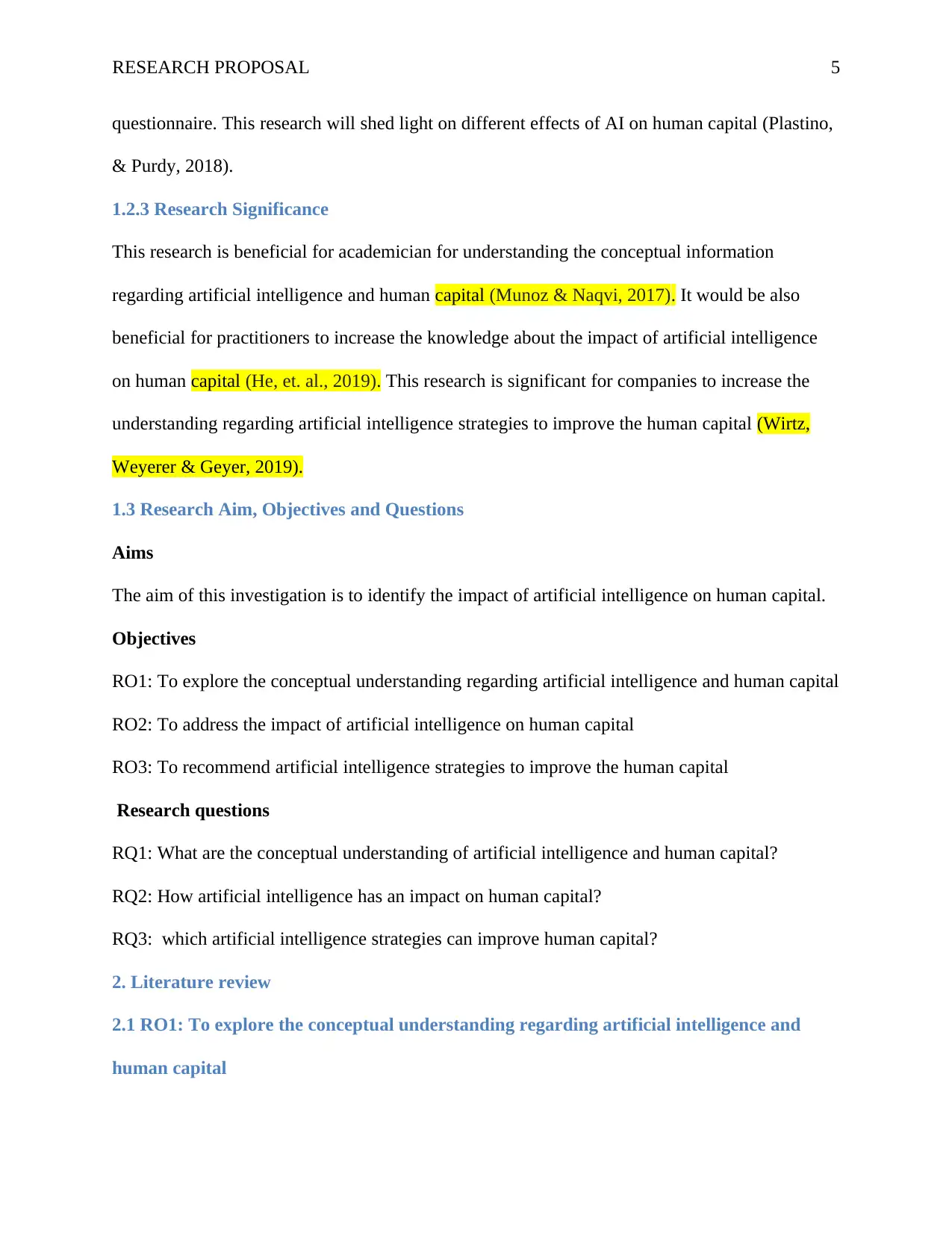
RESEARCH PROPOSAL 5
questionnaire. This research will shed light on different effects of AI on human capital (Plastino,
& Purdy, 2018).
1.2.3 Research Significance
This research is beneficial for academician for understanding the conceptual information
regarding artificial intelligence and human capital (Munoz & Naqvi, 2017). It would be also
beneficial for practitioners to increase the knowledge about the impact of artificial intelligence
on human capital (He, et. al., 2019). This research is significant for companies to increase the
understanding regarding artificial intelligence strategies to improve the human capital (Wirtz,
Weyerer & Geyer, 2019).
1.3 Research Aim, Objectives and Questions
Aims
The aim of this investigation is to identify the impact of artificial intelligence on human capital.
Objectives
RO1: To explore the conceptual understanding regarding artificial intelligence and human capital
RO2: To address the impact of artificial intelligence on human capital
RO3: To recommend artificial intelligence strategies to improve the human capital
Research questions
RQ1: What are the conceptual understanding of artificial intelligence and human capital?
RQ2: How artificial intelligence has an impact on human capital?
RQ3: which artificial intelligence strategies can improve human capital?
2. Literature review
2.1 RO1: To explore the conceptual understanding regarding artificial intelligence and
human capital
questionnaire. This research will shed light on different effects of AI on human capital (Plastino,
& Purdy, 2018).
1.2.3 Research Significance
This research is beneficial for academician for understanding the conceptual information
regarding artificial intelligence and human capital (Munoz & Naqvi, 2017). It would be also
beneficial for practitioners to increase the knowledge about the impact of artificial intelligence
on human capital (He, et. al., 2019). This research is significant for companies to increase the
understanding regarding artificial intelligence strategies to improve the human capital (Wirtz,
Weyerer & Geyer, 2019).
1.3 Research Aim, Objectives and Questions
Aims
The aim of this investigation is to identify the impact of artificial intelligence on human capital.
Objectives
RO1: To explore the conceptual understanding regarding artificial intelligence and human capital
RO2: To address the impact of artificial intelligence on human capital
RO3: To recommend artificial intelligence strategies to improve the human capital
Research questions
RQ1: What are the conceptual understanding of artificial intelligence and human capital?
RQ2: How artificial intelligence has an impact on human capital?
RQ3: which artificial intelligence strategies can improve human capital?
2. Literature review
2.1 RO1: To explore the conceptual understanding regarding artificial intelligence and
human capital
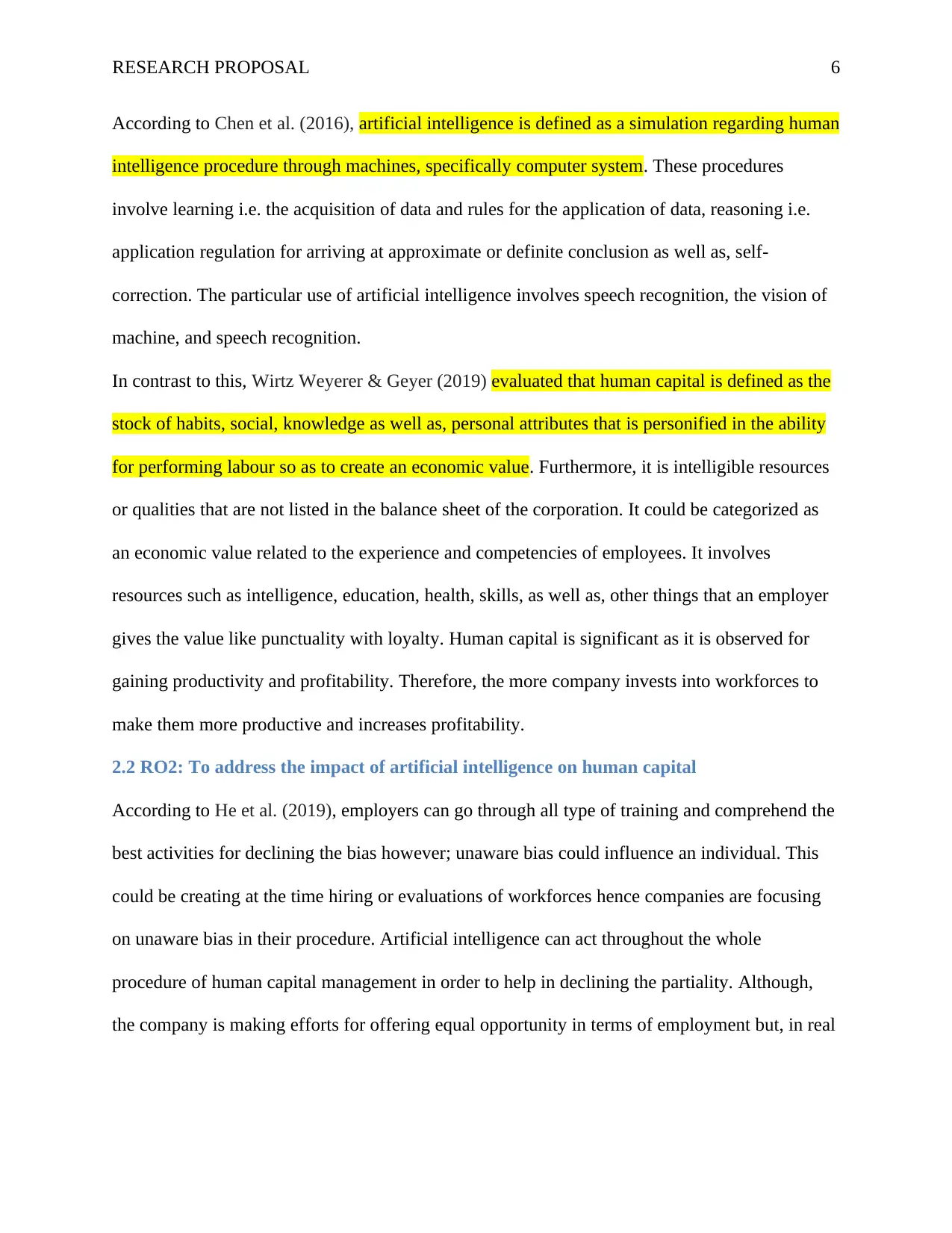
RESEARCH PROPOSAL 6
According to Chen et al. (2016), artificial intelligence is defined as a simulation regarding human
intelligence procedure through machines, specifically computer system. These procedures
involve learning i.e. the acquisition of data and rules for the application of data, reasoning i.e.
application regulation for arriving at approximate or definite conclusion as well as, self-
correction. The particular use of artificial intelligence involves speech recognition, the vision of
machine, and speech recognition.
In contrast to this, Wirtz Weyerer & Geyer (2019) evaluated that human capital is defined as the
stock of habits, social, knowledge as well as, personal attributes that is personified in the ability
for performing labour so as to create an economic value. Furthermore, it is intelligible resources
or qualities that are not listed in the balance sheet of the corporation. It could be categorized as
an economic value related to the experience and competencies of employees. It involves
resources such as intelligence, education, health, skills, as well as, other things that an employer
gives the value like punctuality with loyalty. Human capital is significant as it is observed for
gaining productivity and profitability. Therefore, the more company invests into workforces to
make them more productive and increases profitability.
2.2 RO2: To address the impact of artificial intelligence on human capital
According to He et al. (2019), employers can go through all type of training and comprehend the
best activities for declining the bias however; unaware bias could influence an individual. This
could be creating at the time hiring or evaluations of workforces hence companies are focusing
on unaware bias in their procedure. Artificial intelligence can act throughout the whole
procedure of human capital management in order to help in declining the partiality. Although,
the company is making efforts for offering equal opportunity in terms of employment but, in real
According to Chen et al. (2016), artificial intelligence is defined as a simulation regarding human
intelligence procedure through machines, specifically computer system. These procedures
involve learning i.e. the acquisition of data and rules for the application of data, reasoning i.e.
application regulation for arriving at approximate or definite conclusion as well as, self-
correction. The particular use of artificial intelligence involves speech recognition, the vision of
machine, and speech recognition.
In contrast to this, Wirtz Weyerer & Geyer (2019) evaluated that human capital is defined as the
stock of habits, social, knowledge as well as, personal attributes that is personified in the ability
for performing labour so as to create an economic value. Furthermore, it is intelligible resources
or qualities that are not listed in the balance sheet of the corporation. It could be categorized as
an economic value related to the experience and competencies of employees. It involves
resources such as intelligence, education, health, skills, as well as, other things that an employer
gives the value like punctuality with loyalty. Human capital is significant as it is observed for
gaining productivity and profitability. Therefore, the more company invests into workforces to
make them more productive and increases profitability.
2.2 RO2: To address the impact of artificial intelligence on human capital
According to He et al. (2019), employers can go through all type of training and comprehend the
best activities for declining the bias however; unaware bias could influence an individual. This
could be creating at the time hiring or evaluations of workforces hence companies are focusing
on unaware bias in their procedure. Artificial intelligence can act throughout the whole
procedure of human capital management in order to help in declining the partiality. Although,
the company is making efforts for offering equal opportunity in terms of employment but, in real
⊘ This is a preview!⊘
Do you want full access?
Subscribe today to unlock all pages.

Trusted by 1+ million students worldwide
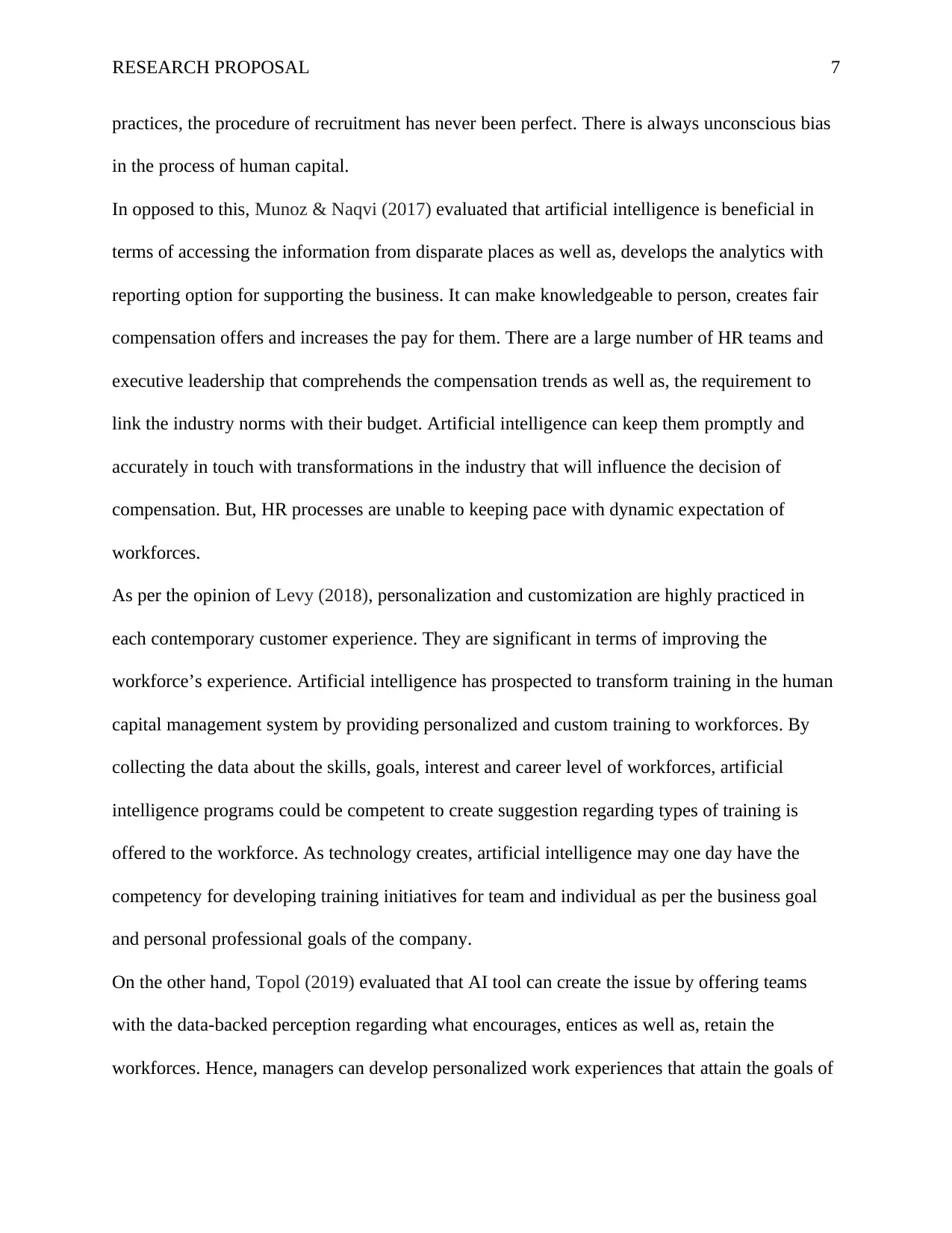
RESEARCH PROPOSAL 7
practices, the procedure of recruitment has never been perfect. There is always unconscious bias
in the process of human capital.
In opposed to this, Munoz & Naqvi (2017) evaluated that artificial intelligence is beneficial in
terms of accessing the information from disparate places as well as, develops the analytics with
reporting option for supporting the business. It can make knowledgeable to person, creates fair
compensation offers and increases the pay for them. There are a large number of HR teams and
executive leadership that comprehends the compensation trends as well as, the requirement to
link the industry norms with their budget. Artificial intelligence can keep them promptly and
accurately in touch with transformations in the industry that will influence the decision of
compensation. But, HR processes are unable to keeping pace with dynamic expectation of
workforces.
As per the opinion of Levy (2018), personalization and customization are highly practiced in
each contemporary customer experience. They are significant in terms of improving the
workforce’s experience. Artificial intelligence has prospected to transform training in the human
capital management system by providing personalized and custom training to workforces. By
collecting the data about the skills, goals, interest and career level of workforces, artificial
intelligence programs could be competent to create suggestion regarding types of training is
offered to the workforce. As technology creates, artificial intelligence may one day have the
competency for developing training initiatives for team and individual as per the business goal
and personal professional goals of the company.
On the other hand, Topol (2019) evaluated that AI tool can create the issue by offering teams
with the data-backed perception regarding what encourages, entices as well as, retain the
workforces. Hence, managers can develop personalized work experiences that attain the goals of
practices, the procedure of recruitment has never been perfect. There is always unconscious bias
in the process of human capital.
In opposed to this, Munoz & Naqvi (2017) evaluated that artificial intelligence is beneficial in
terms of accessing the information from disparate places as well as, develops the analytics with
reporting option for supporting the business. It can make knowledgeable to person, creates fair
compensation offers and increases the pay for them. There are a large number of HR teams and
executive leadership that comprehends the compensation trends as well as, the requirement to
link the industry norms with their budget. Artificial intelligence can keep them promptly and
accurately in touch with transformations in the industry that will influence the decision of
compensation. But, HR processes are unable to keeping pace with dynamic expectation of
workforces.
As per the opinion of Levy (2018), personalization and customization are highly practiced in
each contemporary customer experience. They are significant in terms of improving the
workforce’s experience. Artificial intelligence has prospected to transform training in the human
capital management system by providing personalized and custom training to workforces. By
collecting the data about the skills, goals, interest and career level of workforces, artificial
intelligence programs could be competent to create suggestion regarding types of training is
offered to the workforce. As technology creates, artificial intelligence may one day have the
competency for developing training initiatives for team and individual as per the business goal
and personal professional goals of the company.
On the other hand, Topol (2019) evaluated that AI tool can create the issue by offering teams
with the data-backed perception regarding what encourages, entices as well as, retain the
workforces. Hence, managers can develop personalized work experiences that attain the goals of
Paraphrase This Document
Need a fresh take? Get an instant paraphrase of this document with our AI Paraphraser
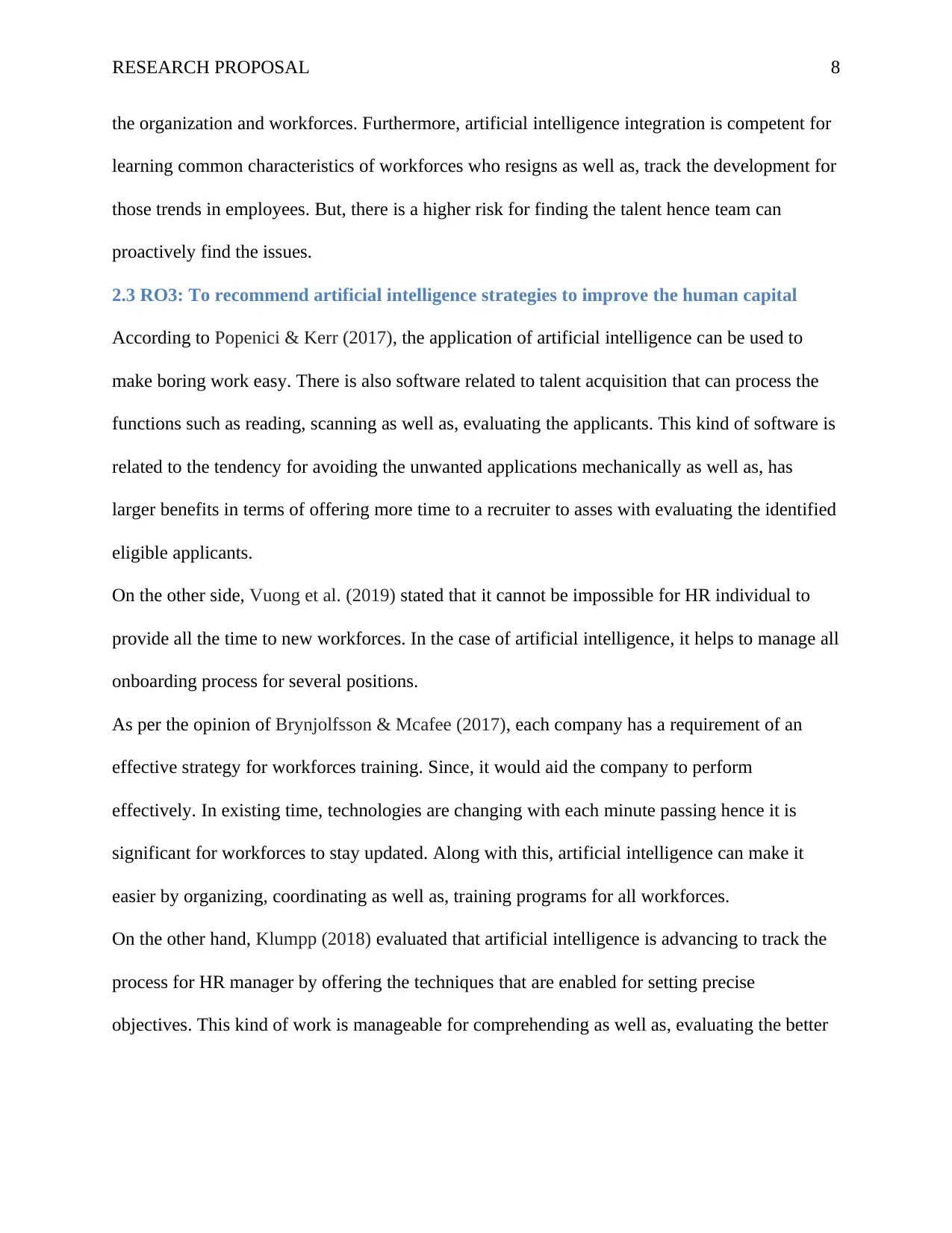
RESEARCH PROPOSAL 8
the organization and workforces. Furthermore, artificial intelligence integration is competent for
learning common characteristics of workforces who resigns as well as, track the development for
those trends in employees. But, there is a higher risk for finding the talent hence team can
proactively find the issues.
2.3 RO3: To recommend artificial intelligence strategies to improve the human capital
According to Popenici & Kerr (2017), the application of artificial intelligence can be used to
make boring work easy. There is also software related to talent acquisition that can process the
functions such as reading, scanning as well as, evaluating the applicants. This kind of software is
related to the tendency for avoiding the unwanted applications mechanically as well as, has
larger benefits in terms of offering more time to a recruiter to asses with evaluating the identified
eligible applicants.
On the other side, Vuong et al. (2019) stated that it cannot be impossible for HR individual to
provide all the time to new workforces. In the case of artificial intelligence, it helps to manage all
onboarding process for several positions.
As per the opinion of Brynjolfsson & Mcafee (2017), each company has a requirement of an
effective strategy for workforces training. Since, it would aid the company to perform
effectively. In existing time, technologies are changing with each minute passing hence it is
significant for workforces to stay updated. Along with this, artificial intelligence can make it
easier by organizing, coordinating as well as, training programs for all workforces.
On the other hand, Klumpp (2018) evaluated that artificial intelligence is advancing to track the
process for HR manager by offering the techniques that are enabled for setting precise
objectives. This kind of work is manageable for comprehending as well as, evaluating the better
the organization and workforces. Furthermore, artificial intelligence integration is competent for
learning common characteristics of workforces who resigns as well as, track the development for
those trends in employees. But, there is a higher risk for finding the talent hence team can
proactively find the issues.
2.3 RO3: To recommend artificial intelligence strategies to improve the human capital
According to Popenici & Kerr (2017), the application of artificial intelligence can be used to
make boring work easy. There is also software related to talent acquisition that can process the
functions such as reading, scanning as well as, evaluating the applicants. This kind of software is
related to the tendency for avoiding the unwanted applications mechanically as well as, has
larger benefits in terms of offering more time to a recruiter to asses with evaluating the identified
eligible applicants.
On the other side, Vuong et al. (2019) stated that it cannot be impossible for HR individual to
provide all the time to new workforces. In the case of artificial intelligence, it helps to manage all
onboarding process for several positions.
As per the opinion of Brynjolfsson & Mcafee (2017), each company has a requirement of an
effective strategy for workforces training. Since, it would aid the company to perform
effectively. In existing time, technologies are changing with each minute passing hence it is
significant for workforces to stay updated. Along with this, artificial intelligence can make it
easier by organizing, coordinating as well as, training programs for all workforces.
On the other hand, Klumpp (2018) evaluated that artificial intelligence is advancing to track the
process for HR manager by offering the techniques that are enabled for setting precise
objectives. This kind of work is manageable for comprehending as well as, evaluating the better
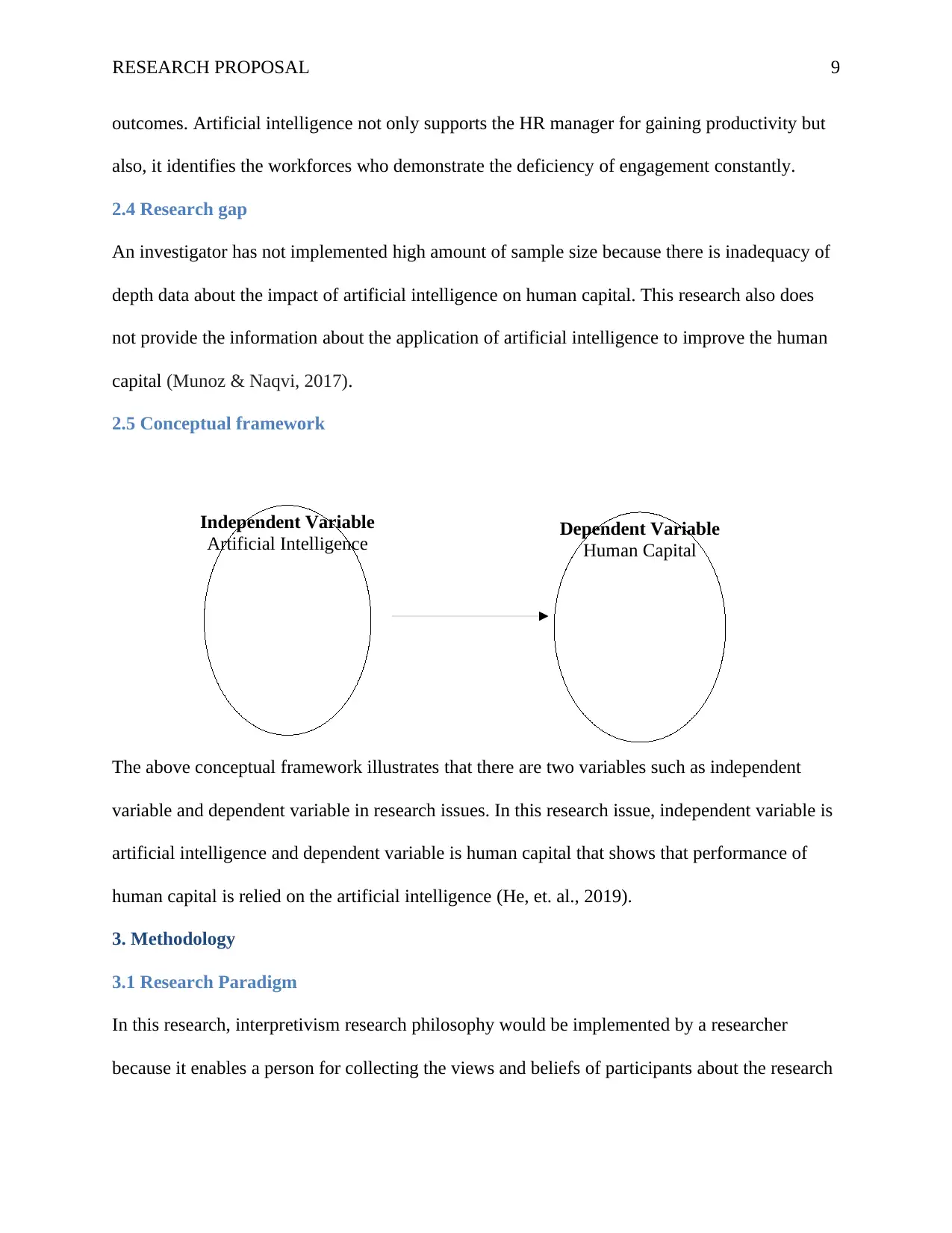
Independent Variable
Artificial Intelligence Dependent Variable
Human Capital
RESEARCH PROPOSAL 9
outcomes. Artificial intelligence not only supports the HR manager for gaining productivity but
also, it identifies the workforces who demonstrate the deficiency of engagement constantly.
2.4 Research gap
An investigator has not implemented high amount of sample size because there is inadequacy of
depth data about the impact of artificial intelligence on human capital. This research also does
not provide the information about the application of artificial intelligence to improve the human
capital (Munoz & Naqvi, 2017).
2.5 Conceptual framework
The above conceptual framework illustrates that there are two variables such as independent
variable and dependent variable in research issues. In this research issue, independent variable is
artificial intelligence and dependent variable is human capital that shows that performance of
human capital is relied on the artificial intelligence (He, et. al., 2019).
3. Methodology
3.1 Research Paradigm
In this research, interpretivism research philosophy would be implemented by a researcher
because it enables a person for collecting the views and beliefs of participants about the research
Artificial Intelligence Dependent Variable
Human Capital
RESEARCH PROPOSAL 9
outcomes. Artificial intelligence not only supports the HR manager for gaining productivity but
also, it identifies the workforces who demonstrate the deficiency of engagement constantly.
2.4 Research gap
An investigator has not implemented high amount of sample size because there is inadequacy of
depth data about the impact of artificial intelligence on human capital. This research also does
not provide the information about the application of artificial intelligence to improve the human
capital (Munoz & Naqvi, 2017).
2.5 Conceptual framework
The above conceptual framework illustrates that there are two variables such as independent
variable and dependent variable in research issues. In this research issue, independent variable is
artificial intelligence and dependent variable is human capital that shows that performance of
human capital is relied on the artificial intelligence (He, et. al., 2019).
3. Methodology
3.1 Research Paradigm
In this research, interpretivism research philosophy would be implemented by a researcher
because it enables a person for collecting the views and beliefs of participants about the research
⊘ This is a preview!⊘
Do you want full access?
Subscribe today to unlock all pages.

Trusted by 1+ million students worldwide
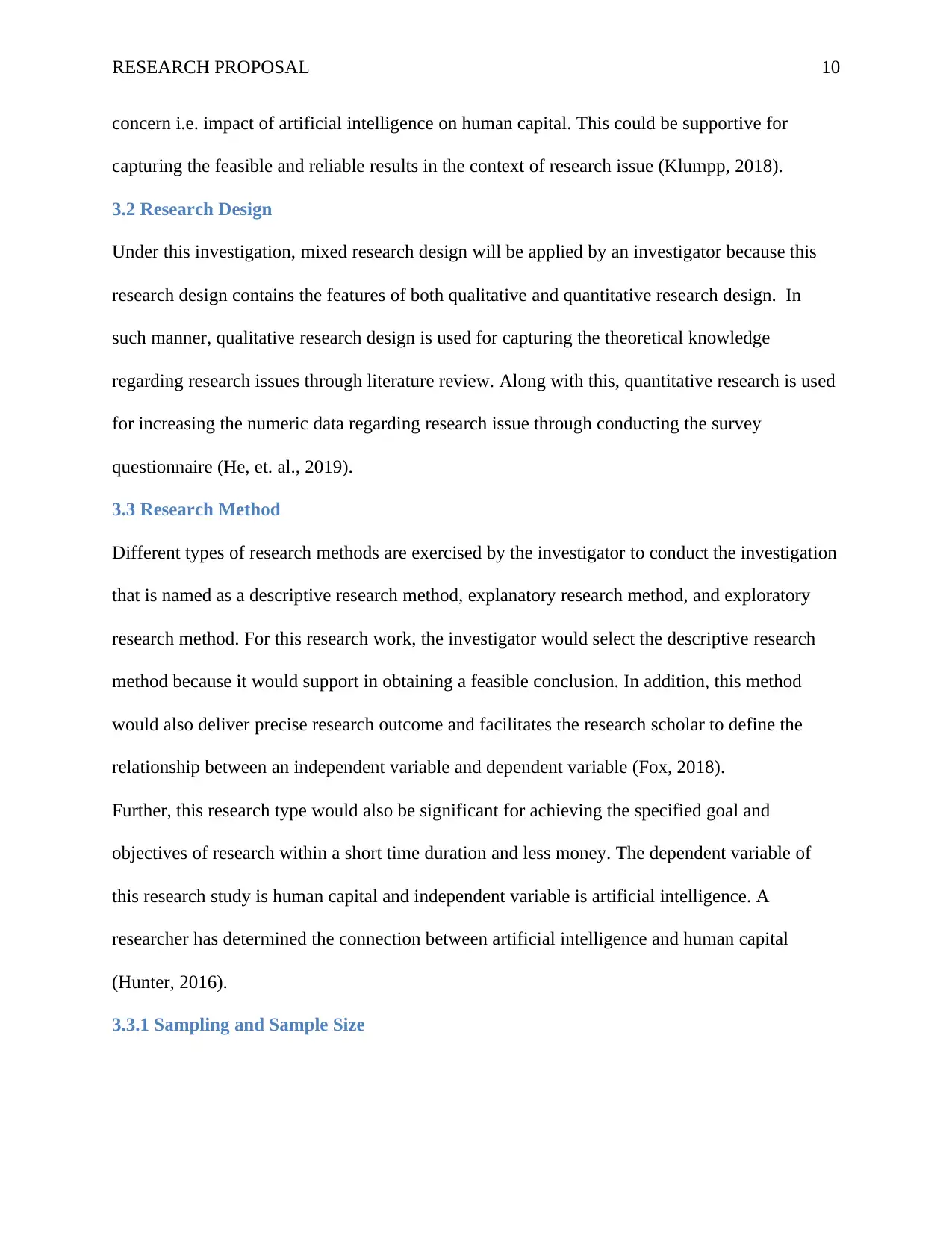
RESEARCH PROPOSAL 10
concern i.e. impact of artificial intelligence on human capital. This could be supportive for
capturing the feasible and reliable results in the context of research issue (Klumpp, 2018).
3.2 Research Design
Under this investigation, mixed research design will be applied by an investigator because this
research design contains the features of both qualitative and quantitative research design. In
such manner, qualitative research design is used for capturing the theoretical knowledge
regarding research issues through literature review. Along with this, quantitative research is used
for increasing the numeric data regarding research issue through conducting the survey
questionnaire (He, et. al., 2019).
3.3 Research Method
Different types of research methods are exercised by the investigator to conduct the investigation
that is named as a descriptive research method, explanatory research method, and exploratory
research method. For this research work, the investigator would select the descriptive research
method because it would support in obtaining a feasible conclusion. In addition, this method
would also deliver precise research outcome and facilitates the research scholar to define the
relationship between an independent variable and dependent variable (Fox, 2018).
Further, this research type would also be significant for achieving the specified goal and
objectives of research within a short time duration and less money. The dependent variable of
this research study is human capital and independent variable is artificial intelligence. A
researcher has determined the connection between artificial intelligence and human capital
(Hunter, 2016).
3.3.1 Sampling and Sample Size
concern i.e. impact of artificial intelligence on human capital. This could be supportive for
capturing the feasible and reliable results in the context of research issue (Klumpp, 2018).
3.2 Research Design
Under this investigation, mixed research design will be applied by an investigator because this
research design contains the features of both qualitative and quantitative research design. In
such manner, qualitative research design is used for capturing the theoretical knowledge
regarding research issues through literature review. Along with this, quantitative research is used
for increasing the numeric data regarding research issue through conducting the survey
questionnaire (He, et. al., 2019).
3.3 Research Method
Different types of research methods are exercised by the investigator to conduct the investigation
that is named as a descriptive research method, explanatory research method, and exploratory
research method. For this research work, the investigator would select the descriptive research
method because it would support in obtaining a feasible conclusion. In addition, this method
would also deliver precise research outcome and facilitates the research scholar to define the
relationship between an independent variable and dependent variable (Fox, 2018).
Further, this research type would also be significant for achieving the specified goal and
objectives of research within a short time duration and less money. The dependent variable of
this research study is human capital and independent variable is artificial intelligence. A
researcher has determined the connection between artificial intelligence and human capital
(Hunter, 2016).
3.3.1 Sampling and Sample Size
Paraphrase This Document
Need a fresh take? Get an instant paraphrase of this document with our AI Paraphraser
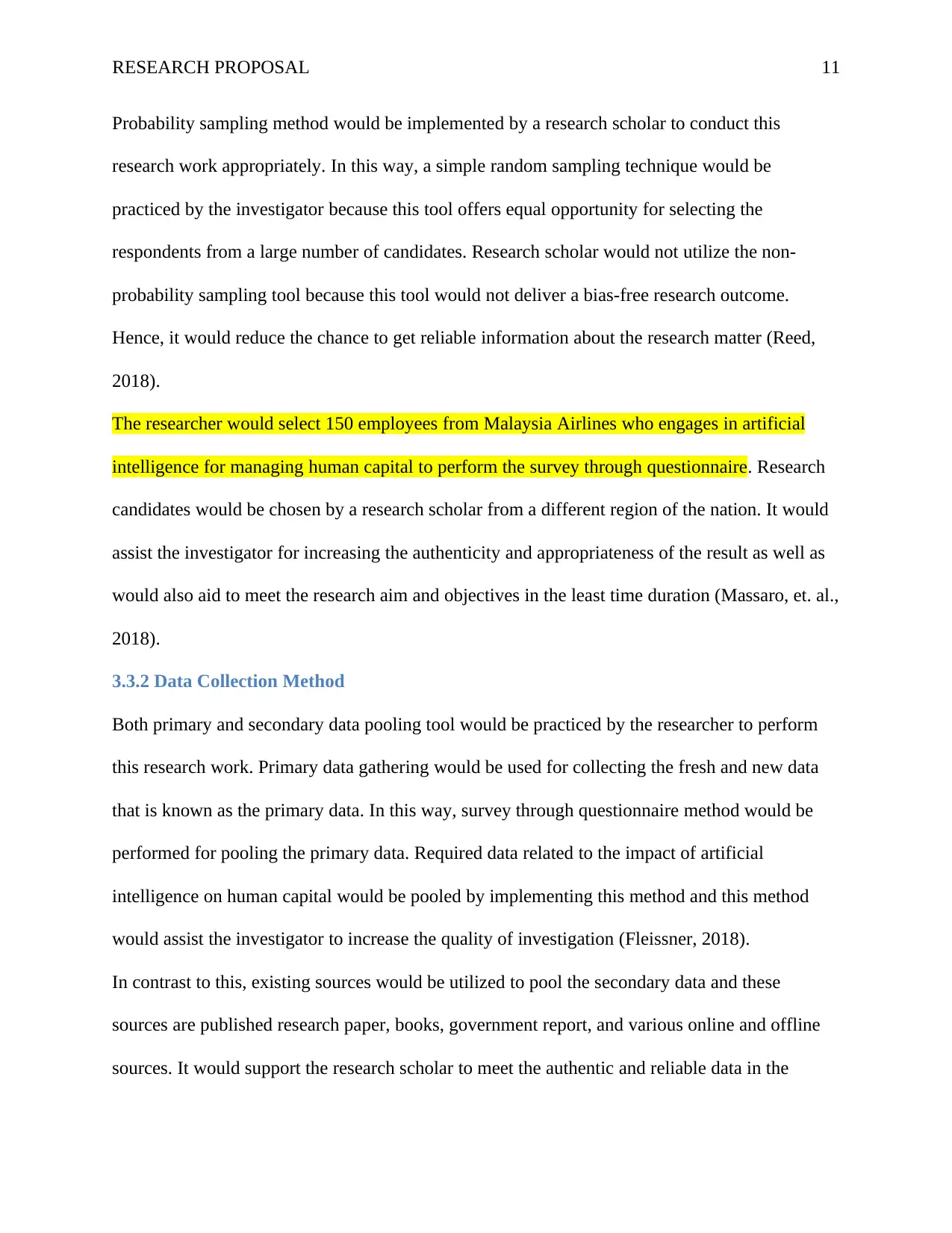
RESEARCH PROPOSAL 11
Probability sampling method would be implemented by a research scholar to conduct this
research work appropriately. In this way, a simple random sampling technique would be
practiced by the investigator because this tool offers equal opportunity for selecting the
respondents from a large number of candidates. Research scholar would not utilize the non-
probability sampling tool because this tool would not deliver a bias-free research outcome.
Hence, it would reduce the chance to get reliable information about the research matter (Reed,
2018).
The researcher would select 150 employees from Malaysia Airlines who engages in artificial
intelligence for managing human capital to perform the survey through questionnaire. Research
candidates would be chosen by a research scholar from a different region of the nation. It would
assist the investigator for increasing the authenticity and appropriateness of the result as well as
would also aid to meet the research aim and objectives in the least time duration (Massaro, et. al.,
2018).
3.3.2 Data Collection Method
Both primary and secondary data pooling tool would be practiced by the researcher to perform
this research work. Primary data gathering would be used for collecting the fresh and new data
that is known as the primary data. In this way, survey through questionnaire method would be
performed for pooling the primary data. Required data related to the impact of artificial
intelligence on human capital would be pooled by implementing this method and this method
would assist the investigator to increase the quality of investigation (Fleissner, 2018).
In contrast to this, existing sources would be utilized to pool the secondary data and these
sources are published research paper, books, government report, and various online and offline
sources. It would support the research scholar to meet the authentic and reliable data in the
Probability sampling method would be implemented by a research scholar to conduct this
research work appropriately. In this way, a simple random sampling technique would be
practiced by the investigator because this tool offers equal opportunity for selecting the
respondents from a large number of candidates. Research scholar would not utilize the non-
probability sampling tool because this tool would not deliver a bias-free research outcome.
Hence, it would reduce the chance to get reliable information about the research matter (Reed,
2018).
The researcher would select 150 employees from Malaysia Airlines who engages in artificial
intelligence for managing human capital to perform the survey through questionnaire. Research
candidates would be chosen by a research scholar from a different region of the nation. It would
assist the investigator for increasing the authenticity and appropriateness of the result as well as
would also aid to meet the research aim and objectives in the least time duration (Massaro, et. al.,
2018).
3.3.2 Data Collection Method
Both primary and secondary data pooling tool would be practiced by the researcher to perform
this research work. Primary data gathering would be used for collecting the fresh and new data
that is known as the primary data. In this way, survey through questionnaire method would be
performed for pooling the primary data. Required data related to the impact of artificial
intelligence on human capital would be pooled by implementing this method and this method
would assist the investigator to increase the quality of investigation (Fleissner, 2018).
In contrast to this, existing sources would be utilized to pool the secondary data and these
sources are published research paper, books, government report, and various online and offline
sources. It would support the research scholar to meet the authentic and reliable data in the
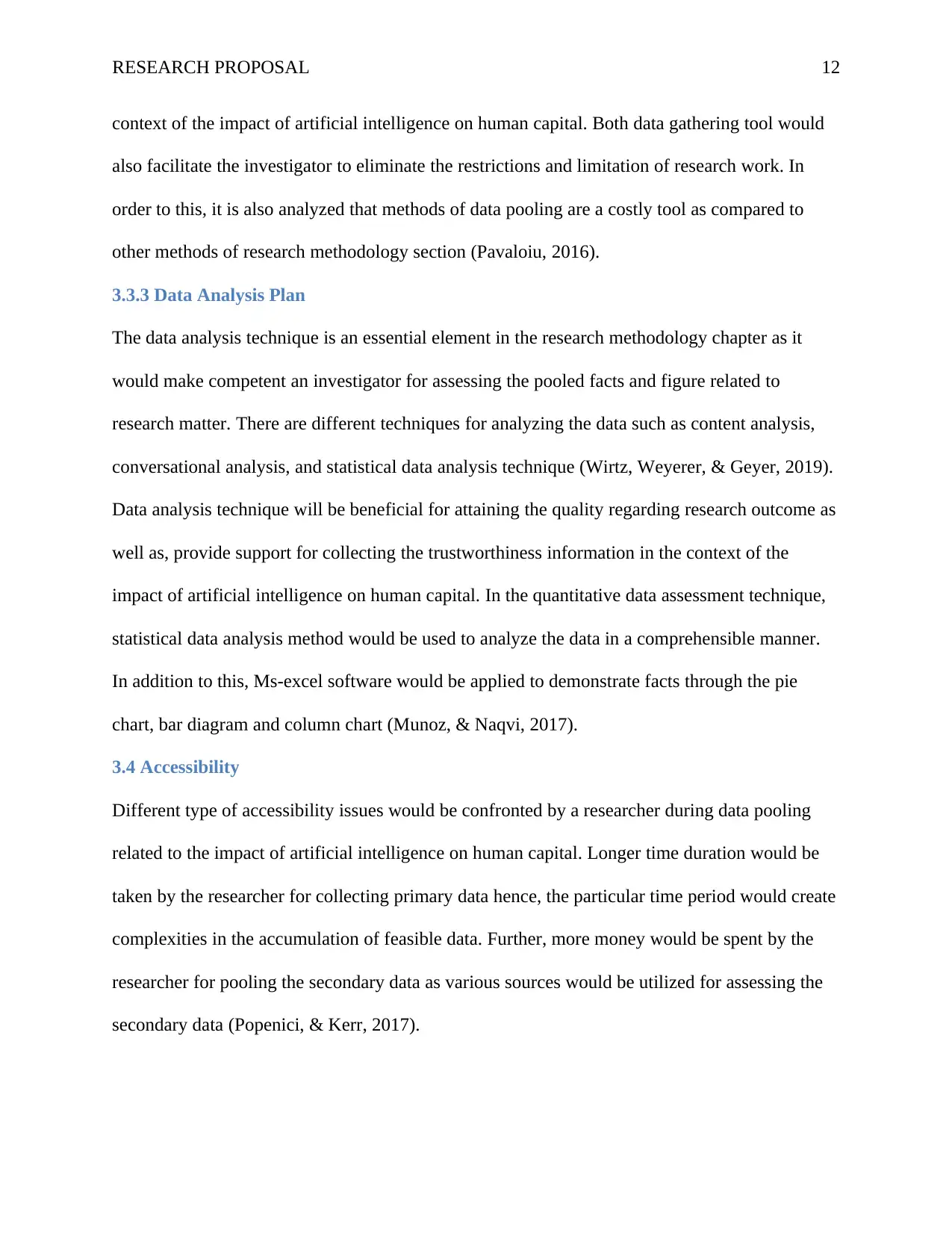
RESEARCH PROPOSAL 12
context of the impact of artificial intelligence on human capital. Both data gathering tool would
also facilitate the investigator to eliminate the restrictions and limitation of research work. In
order to this, it is also analyzed that methods of data pooling are a costly tool as compared to
other methods of research methodology section (Pavaloiu, 2016).
3.3.3 Data Analysis Plan
The data analysis technique is an essential element in the research methodology chapter as it
would make competent an investigator for assessing the pooled facts and figure related to
research matter. There are different techniques for analyzing the data such as content analysis,
conversational analysis, and statistical data analysis technique (Wirtz, Weyerer, & Geyer, 2019).
Data analysis technique will be beneficial for attaining the quality regarding research outcome as
well as, provide support for collecting the trustworthiness information in the context of the
impact of artificial intelligence on human capital. In the quantitative data assessment technique,
statistical data analysis method would be used to analyze the data in a comprehensible manner.
In addition to this, Ms-excel software would be applied to demonstrate facts through the pie
chart, bar diagram and column chart (Munoz, & Naqvi, 2017).
3.4 Accessibility
Different type of accessibility issues would be confronted by a researcher during data pooling
related to the impact of artificial intelligence on human capital. Longer time duration would be
taken by the researcher for collecting primary data hence, the particular time period would create
complexities in the accumulation of feasible data. Further, more money would be spent by the
researcher for pooling the secondary data as various sources would be utilized for assessing the
secondary data (Popenici, & Kerr, 2017).
context of the impact of artificial intelligence on human capital. Both data gathering tool would
also facilitate the investigator to eliminate the restrictions and limitation of research work. In
order to this, it is also analyzed that methods of data pooling are a costly tool as compared to
other methods of research methodology section (Pavaloiu, 2016).
3.3.3 Data Analysis Plan
The data analysis technique is an essential element in the research methodology chapter as it
would make competent an investigator for assessing the pooled facts and figure related to
research matter. There are different techniques for analyzing the data such as content analysis,
conversational analysis, and statistical data analysis technique (Wirtz, Weyerer, & Geyer, 2019).
Data analysis technique will be beneficial for attaining the quality regarding research outcome as
well as, provide support for collecting the trustworthiness information in the context of the
impact of artificial intelligence on human capital. In the quantitative data assessment technique,
statistical data analysis method would be used to analyze the data in a comprehensible manner.
In addition to this, Ms-excel software would be applied to demonstrate facts through the pie
chart, bar diagram and column chart (Munoz, & Naqvi, 2017).
3.4 Accessibility
Different type of accessibility issues would be confronted by a researcher during data pooling
related to the impact of artificial intelligence on human capital. Longer time duration would be
taken by the researcher for collecting primary data hence, the particular time period would create
complexities in the accumulation of feasible data. Further, more money would be spent by the
researcher for pooling the secondary data as various sources would be utilized for assessing the
secondary data (Popenici, & Kerr, 2017).
⊘ This is a preview!⊘
Do you want full access?
Subscribe today to unlock all pages.

Trusted by 1+ million students worldwide
1 out of 18
Related Documents
Your All-in-One AI-Powered Toolkit for Academic Success.
+13062052269
info@desklib.com
Available 24*7 on WhatsApp / Email
![[object Object]](/_next/static/media/star-bottom.7253800d.svg)
Unlock your academic potential
Copyright © 2020–2025 A2Z Services. All Rights Reserved. Developed and managed by ZUCOL.



